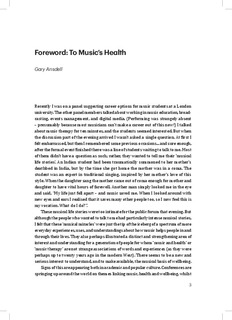| dc.description.abstract | Foreword to "Musical life stories : narratives on health musicking". -
Musical Life Stories makes an important and significant contribution to thes refreshing and remembering of practice and theory that is currently taking place in the area of music, health and wellbeing. Its contributors are about half music therapists, and half other professionals (musicologist, educationalist, nursing researcher, psychologist). Together they present crucial empirical confirmation of key dimensions of the broader picture that is rapidly assembling, which could be summarised as showing how:
• Music is intensely personal for most people – they experience music (in relation to their personal preferences and activities) as infusing, accompanying and guiding their everyday lives in temporal, spatial and action-based dimensions. In short, music is often the soundtrack to a life, and therefore a means of ‘giving voice’ to, performing, and narrating a life.
• Because of this intimate personal link, for many people music is quite naturally linked to wellbeing (whether they are ‘well’ or ‘ill’ in an objective sense, or somewhere between – as indeed most of us typically are most of the time).
• People often personify music in this way as a kind of ‘lay-therapist’ within their everyday lives – or, alternatively, they themselves are the lay music therapist using music as a tool for their own self-care in areas of energy and motivation, emotion and emotional regulation, identity, relationship, socialisation, restorative ‘asylum’, and self-reflective work in relation to everyday problems and challenges.
• Music is therefore as much a health-promoter and illness-preventer as a ‘treatment’.
The key importance of Musical Life Stories is that this people-music-health link is presented not as theoretical speculation, but as something established and substantiated through a ‘delicate empiricism’ consisting mainly of ethnographic-style studies that
search for, identify, trace, and follow the link within specific actions and occasions (this is the vital lesson that Tia DeNora, Bruno Latour and the ethnomethodologists have drummed into us – show the links at work!). And this is just what the authors of
this compendium try to do. These studies, and other converging research now available, seems to me to be providing a new broad-based practical and theoretical platform from which we can begin to talk more usefully about both interdisciplinary and inter-professional differences and shared agendas and concerns. | nb_NO |
